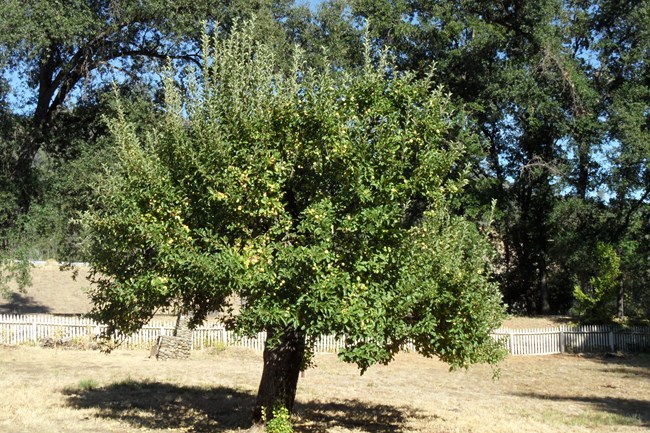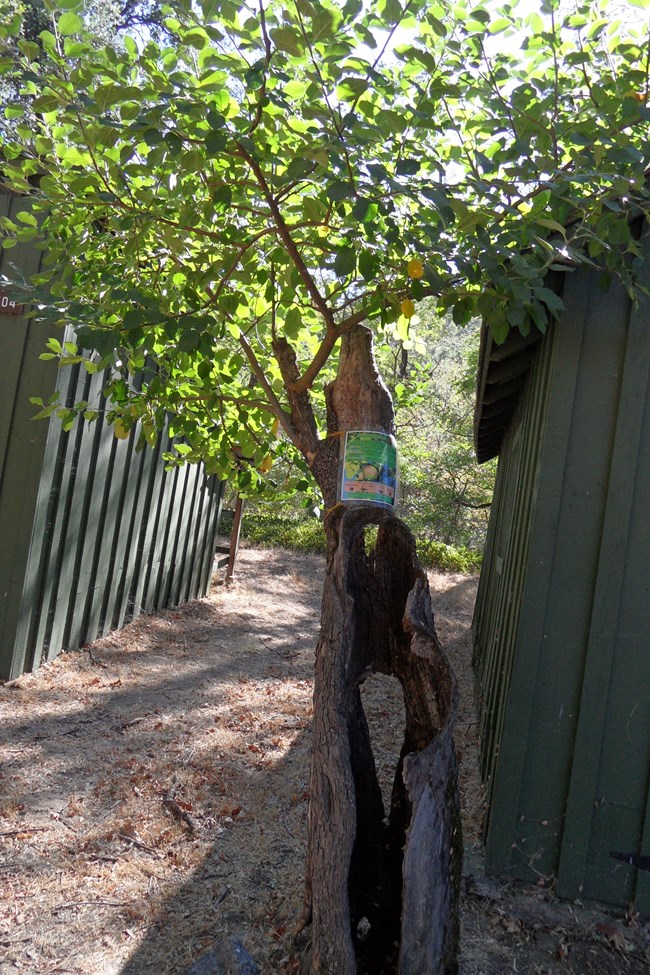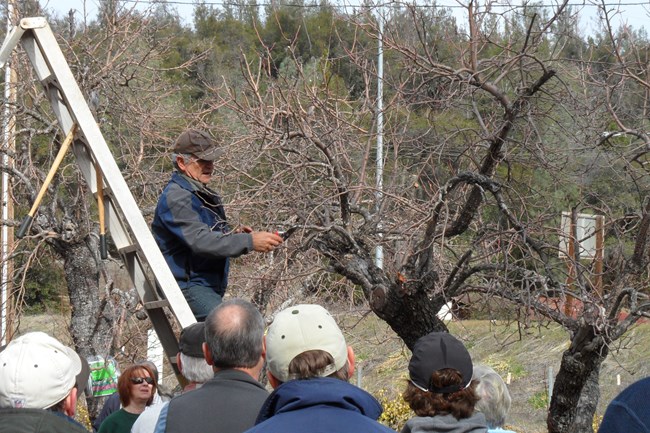Last updated: April 7, 2025
Article
Podcast 046: Restoration of the Camden House Orchard with arborist Rico Montenegro

Rico Montenegro
Camden House
Paul Cady: So the first question I was wondering about was how did you originally become involved with the Camden House?
Rico Montenegro: Well, I’ve been involved with the Camden House orchard at Whiskeytown National Recreation Area for at least 13 years. At the time I was involved with the construction of a new botanical garden for a new museum and garden complex called Turtle Bay in Redding, CA.
Rico Montenegro: I was also teaching in the Horticulture Department at a local college called Shasta College. I had previously been involved with managing a university botanical garden in southern California that had at the time the largest collection of fruit trees of any garden in California and it was certainly the most popular of any of the classes I had taught.
Rico Montenegro: So, I had a real interest in this area and when I was made aware of this old orchard up at the Camden House, I went up to visit it. I become friends with the botanist that was there at the time, and I expressed interest in helping to restore it and possibly bringing students and others up to help with its pruning. So I became involved with the orchard, as a volunteer, and little by little, with the restoration of the old apple trees that were associated the Camden House.
Paul Cady: Do you happen to know when the trees were planted and who planted them?
Rico Montenegro: The trees range in age from 100-150 years of age and were planted in association with an early homestead and a hotel that was built to provide a way station and a source of food for travelers that were going from the inland to the coast and back. The site had been developed by early pioneers, prospectors Charles Camden and Levi Tower, who were involved with providing a rest stop and a gateway for travelers to the coast.
Rico Montenegro: They actually had a toll bridge there so people had to pay a toll to cross over the creek to get on the road that took folks over, through the mountains and to the coast where gold and redwoods were located.

Rico Montenegro
Plans for Pruned Trees
Paul Cady: What are you planning on doing with the trees now that you’ve started working on them?
Rico Montenegro: Whiskeytown National National Recreation Area is now really quite committed to the preservation of these old trees and providing some resources to insure their survival. When I first became involved with the orchard it had actually been let go for quite a number of years and the trees had been subject to a lot of neglect and abuse. Originally it was an orchard of about 1,000 fruit trees of all types.
Rico Montenegro: What is left now are about 30-35 apples, some cherries, a few pears and a stand of persimmons that are native to the eastern part of the United States. Some of the pear trees are also quite old with some possibly being original while others may be seedlings. The intent right now has been to do what I can to restore them. Because of the condition of the trees, none of them can be essentially brought back to what they originally were. Somebody years ago went at the trees with a chain saw, leaving trees with very large wounds that never healed.
Rico Montenegro: This resulted in decay, with many of the old trees being heavily damaged. Most of the trees rotted out in their crowns with some losing as much as, some essentially were left with about a quarter of the trunk, and some so decayed that they could easily be pushed over. A few of these trees have maybe two or three inches of cambium tissue left. When I first became involved with these trees, they were heavily infected with fireblight, which is a bacterial infection that causes severe dieback.
Rico Montenegro: The trees, if they were lucky, had fruit that was very small and inferior. But since that time the annual pruning that we do has eliminated the fireblight, though it comes back periodically. The trees are now very productive with lots of fairly good size apples and healthy vigorous growth. There has been some work with the propagation and grafting on new rootstocks off some of these trees and some replanting in one section of the orchard near the Camden House.
Paul Cady: Do you prune overgrown trees differently than the ones that have been pruned for a longer, more consistent, period of time?
Rico Montenegro: Yes, there are basic pruning principals that apply to all tree pruning, but the goals and methods used are different than on a newly planted tree or one that has been pruned and maintained annually. I teach and follow basic pruning principles that are taught by the International Society of Arboriculture. I am a certified arborist.
Rico Montenegro: In a commercial orchard you will always notice that the trees are trained so that they branch fairly low to the ground, so typically I tell people, that you want to train them so that they start their first branch maybe about 18 inches from the ground, that way you can keep the trees lower. And the lower they are, the easier access you have to the fruit and the easier it is to maintain the trees. In earlier years it was a whole different procedure because they had a lot of predators, especially with the wildlife, like deer, but you may have also had problems with bears which is a much harder problem to deal with.
Rico Montenegro: So they typically trained the trees so that they branched very high off the ground and they used orchard ladders to maintain and harvest the fruit. Most of the trees branch fairly high off the ground right now but we are working with staff to reduce their height. All the trees that were pruned heavily in the past with the chain saw were not maintained so the trees grew back up with what we call water sprouts, so they just went straight up. Many of these trees, when I first started working on them, were almost 35-40 feet in height, but with very weak structure.
Rico Montenegro: They had a tendency to split and break apart when they reached a certain height because of poor attachment, because of rot and decay, and sometimes bear climbing up on the trees. Bears love apples, and they can bring whole sections of trees down. So the intent is to reduce the height of the trees using a technique called crown reduction, which is a very specific pruning method for size reduction, as well as doing lacing or thinning out of the trees. As the trees come into production we use pruning techniques that will encourage and emphasize good fruit production.

Rico Montenegro
Workshops on Pruning
Paul Cady: Are you pruning these trees by yourself or have you been able to develop a volunteer core to help you out with this?
Rico Montenegro: Well, the first year I may have worked on the orchard by myself. I then started bringing some college classes that I was teaching up to the orchard as part of the course, then I opened it up to the community. Over the years I have offered classes annually to the community on basic fruit tree care and pruning, starting from young trees up. On the first Saturday in February, I’ve offered a free class on restoration pruning at Whiskeytown National Park [National Recreation Area].
Rico Montenegro: The classes I teach provide information on restoring older trees, particularly fruit trees, though the techniques I teach can be applied to any type of tree. The information I provide helps people learn how to properly manage their own trees. The classes are of particular interest to people who have had trees that have been badly abused, like the ones at the park, or trees that have been let go and neglected and they want to know what I do to restore them. What is most popular is that I encourage people to bring their own pruning tools, and after we’re done with the class they have an opportunity to have some hands on experience.
Rico Montenegro: Years ago, I started off with a handful of people who came up every year to help and learn about how to care for these trees. Over the years this activity has grown. Normally I’d have between 15-20 people show up on a Saturday morning. Last year I had over 40, and this year, I had over 65 people show up. I always hold the activity the first Saturday of February, which is a good time to do the pruning on these old trees in this region, while the trees are still dormant.
Rico Montenegro: The best time for pruning in other regions will vary, depending on their climate. Park staff, this year, was actually taken aback by the number of people who showed up. It was by word-of-mouth and some emails, because I didn’t really have the chance to get it in the paper this time, but the turnout was amazing and people seemed to really appreciate receiving the information and knowing how to accomplish the pruning.
Rico Montenegro: I tell everybody, not only are you going to have an opportunity to have some hands on experience, but then you are going to walk away feeling you’ve made a positive contribution to the [National] Park Service and to the community and the restoration of these old historical trees. People feel really good about that. So they’ve gotten a chance to learn by doing it, they’ve had, or they’ve seen what mistakes others have made, and they then learn how to make corrections, or how to restore damaged older trees.
Rico Montenegro: I always tell people that with young trees figure it’s going to take about 3-4 years to develop the structural framework that will be permanent on that tree. When you’re restoring older trees you’re approaching it from a different goal, so I tell them to figure 5 or 6 years, or it could even be a little bit longer, because you’re going to work on restoring the trees slowly until you’ve gotten it back into a state of structure and productivity.
Rico Montenegro: Most of those trees were in pretty bad shape when I started 13 years ago and they will never fully be restored to what they could have been if they had not been so badly damaged. So the intent is to bring them back into a stable condition so people can see these historical trees and their association with this historical home on the site as well.
Paul Cady: What happens to the fruit when it is ripe?
Rico Montenegro: People are always invited, to come out, especially the volunteers, and taste the fruit. School children enjoy this part when they show up for field trips. Two years ago, and this fall will be the third year, the Park Service held a harvest festival associated with the apples and the old house. They had a minimal amount of advertisement the first year but the response from the community was so great, that they decided again last year to do it with an equal response.
Rico Montenegro: So now they have determined this is going to become an annual event at the park with activities for the kids and even an apple tasting of some of the different fruits. Last year I did two tours of the orchard at the festival and was able to talk to people about coming back and participating in my classes and helping with the trees. That’s probably why, though I didn’t do a survey, so many people showed up this last February to participate in the restoration class that I taught.
Paul Cady: Are you in a partnership with the Park Service to develop a management plan to maintain these trees in the long term?
Rico Montenegro: Yes, that’s evolving right now as they are not only looking at the trees, but they are looking at the whole historical site itself. The house referred, to as the Camden House, is open up on weekends at certain times of the year for tours. Before coming to this region years ago, I managed a botanical garden that had a mid-1800’s historical home on the premises that had become a significant part of the gardens with associated period gardens and activities.
Rico Montenegro: This drew a whole different group of people. The Park Service here has done a lot of work on the house already and are now looking to develop a plan for the house’s use, as well as associated gardens around the house which includes the apple orchard.
Rico Montenegro: I feel really good about what has happened, especially because now the Park Service has a committed to see that this site is preserved and maintained. Just this last year they replaced a decaying redwood water storage tank that was used as the only source of water for irrigation for a section of orchard that’s closest to the house. Most of the trees in outlying areas still don’t get summer irrigation so they just survive on their own without supplemental water.
Rico Montenegro: Hopefully, at some point in the future, the other outlying trees will get supplemental water during the summer months. So the answer, is yes, there is a management plan that’s evolving. The plan also includes the propagation and the preservation of the gene pool that we have with the trees here. Many of the cultivars and varieties growing here are not necessarily available in the trade anymore. Many of them though have been identified, but not all of them as yet.
Historic Orchards
Paul Cady: Before we finish up are there any additional comments you’d like to make about historic orchards and their care?
Rico Montenegro: Some people look at these old trees and question the reason for putting such effort into the restoration and preservation of them and think, are they really worth bringing back? Some fruit trees, especially apple trees, can live as much as 200 years. There’s a real growing interest in these old cultivars.
Rico Montenegro: As I’ve experienced around the country, and because of the work that I do now with the Fruit Tree Planting Foundation, where we donate fruit tree orchards throughout the world, I’ve had the opportunity to come in contact with a number of older growers who are still growing some of these old varieties and cultivars.
Rico Montenegro: People are beginning to realize not only do they have historical significance, but they have attributes that some of the newer varieties and cultivars don’t have. These fruit trees are significant, as people really feel they are part of our living history and fabric. They have a lot of real important things that they bring to our community. I’ve seen communities come together around the planting of community orchards, and here the preservation and restoration of this magnificent old orchard and that’s pretty exciting to me.
Rico Montenegro: I think the Park Service realizes that, and I know across the country there’s a few old orchards associated with historical sites. I think Monticello is an example of that, they have done work for a number of years, on the perseveration of some of their old varieties of fruit trees.
Paul Cady: Alright, well thanks very much for talking with me Rico, I really appreciate it.
Rico Montenegro: Well it’s been a pleasure and it’s been an exciting experience for me over the years volunteering and bringing the community together in the restoration of those old wonderful trees. So, thank you very much for letting me share this.
Paul Cady: Thanks Rico.
Read other Preservation Technology Podcast articles or learn more about the National Center for Preservation Technology and Training.
